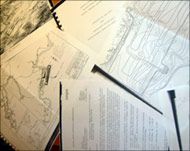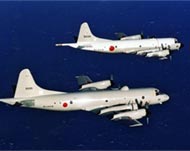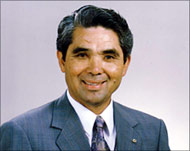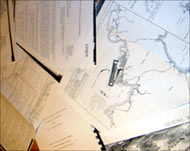Japanese cold to US air base plan
The weather forecasts say a typhoon is approaching the Okinawa islands, but many of the residents of Henoko Bay have their eye on a far larger threat, one that will cause far more damage and linger for decades rather than a few hours.

Out to sea, beyond the two arms of the breakwaters that protect the local fishing fleet, is a solitary limestone outcrop known as Mananu Rock.
If work that has already begun to build an air base for the US Marine Corps is not halted, Mananu Rock will have to make way for an airfield with runways 2.5km long, and obscuring the entire skyline across the bay.
The waves lapping against the sand are too small to make any noise, and the fishing boats are either already well out to sea or on trailers hauled up on to the concrete slipway, so the only sound is of the wind blowing in from the Pacific.
The local people, every one of whom is burnished a deep brown by the hot Okinawan sun, say the calm is deceptive as a storm is approaching.
Our treasure
Once it is built, Henoko Bay residents shudder at the thought of the helicopters and fighter jets that will use it daily.
 |
|
Work has begun on a US air base |
“We’ve been fighting this project for eight years now,” says Yoshii Shimabukuro. “In that time people have died and others have become ill because of it. We’ve put our lives on the line and we can’t just sit still while they try to take our sea away from us.
“The sea is our treasure,” says this feisty 92-year-old, a resident of Henoko for nearly all her life. “During and just after the war, the food we got from the sea kept us alive.” But something else is keeping her alive today, she says.
“I’m going to fight them every step of the way and I won’t let them reclaim the bay,” she says. “And once I know the airport won’t be built, then I’ll be happy to die.”
But Shimabukuro and the rest of the protesters who have staged a sit-in vigil beside the port for more than 2600 days know they are up against a formidable enemy.
Geological survey
On 16 November, vessels chartered by the Japanese government began to piece together a platform from which test bores will be drilled 25 metres into the coral reef and seabed off Henoko to determine the geological make-up of the site before the landfill operation begins.
“We have put our Yoshii Shimabukuro, |
Local people and protesters tried to obstruct the work in canoes and small boats, while on the shore others stood in front of vehicles carrying the construction equipment.
The work was delayed, but local people know the government has vast resources and has stated that the site will be developed.
There are 41,000 US service personnel stationed in Japan, 28,000 of them in Okinawa. And while US facilities can be found across the length of Japan, 75% of the total are in Okinawa.
One of the military facilities that has caused most concern is the Marines’ base at Futenma. Since it was built, the town has expanded around its perimeter wire, and residents say they live in fear of a helicopter, jet or, most worrying of all, a refuelling aircraft being involved in an accident that brings it down on their homes.
Long-held plan
In 1996, Washington agreed to return the land to Japan on the condition that an alternative facility be built to take over its tasks.
 |
|
Residents say they live in fear |
In 2002, the government in Tokyo and the Okinawan prefectural government approved a long-held plan to build a joint military-civilian airfield off Henoko, which is bounded to the north by the US military’s sprawling Camp Schwab.
But opponents of the plan believe the project dates back a lot longer than just eight years. Spreading out photocopied documents bearing a US Department of Defence seal, Yoshikazu Makishi says the “destruction” of the coastline at Henoko dates from 1965.
“The initial project called for the entire bay to be filled in and these plans go as far as marking out where individual buildings were going to be built in the camp,” says Makishi, owner of a construction company and a vehment opponent of the plan.
“The only reason they didn’t go ahead with it back then was because of the Vietnam war – they didn’t have enough money,” he says. “And I don’t have any proof of it, but I believe when Okinawa was handed back to Japan in 1972 by the US, the deal included the eventual completion of this project.”
Secret weapon
Today’s version calls for a 207 square hectare airfield built on reclaimed land – an estimated 17.7 million square metres of soil is needed – and connected to the mainland at Camp Schwab by two 1.5km causeways.
 |
|
Chuuji Chinen led the protests |
Construction is expected to take more than nine years.
While other villages and towns in Okinawa have battled to rid themselves of the presence of US bases, Henoko is deploying a secret weapon of its own: dugongs.
He cannot, of course, appear in court himself to give evidence in the ongoing case, but a dugong, residents of Henoko Bay said, has been named as a plaintiff in the US District Court in San Francisco as the Save the Dugong Network campaigns against the base.
The group argues that the 1966 National Historic Preservation Act requires that the US government protect the creatures’ habitat; the US justice department says the suit should be dismissed because the US did not choose the site of the new airfield.
Likely compensation
The environmentalists’ case is supported by the endangered dugong being classified as a natural monument by the Japanese government. A ruling is expected in the near future.
 |
|
Henoko coastline’s fate is the |
The issue on the ground is complicated by some people in Henoko in favour of the airfield project, because of the compensation they are likely to receive or because of the additional trade that it might bring to a relative backwater in the prefecture.
“This is the third time I have been here and I’ll stay here a week or so before I have to go back to university,” 22-year-old Ayumi Kumate said.
“Before I came the first time I didn’t know much about the issue, but I soon learned that 80% of the people are against the bases but no one is listening to them.”
Kumate, who is studying Spanish at Tokyo’s Sophia University, is living at the shelter set up for volunteers and local people continuing the protest beside the harbour.
Two policemen keep a close eye on the demonstrators and the ships and drilling equipment stacked on the jetties.
‘We will succeed’
|
“Other people can learn from our experience here and if more people from Okinawa and other places join the protest, we will succeed” Ayumi Kumate,student protester |
“I never knew how much this affected people here before I first visited and I think people in other parts of Japan, and around the world, don’t realise how badly local people are suffer-ing,” Kumate said.
“These people have been suffering since before World War II; when that was over they hoped they would be left in peace, but then the Japanese government forced them to accept these bases.
“I’ll do my best to stop the airport being built, and I believe we will win in the end,” Kumate said. “Many people are protesting with us now and we will continue the struggle. Just because they are starting work, it does not mean it is all over.
She added: “Other people can learn from our experience here and if more people from Okinawa and other places join the protest, we will succeed.”